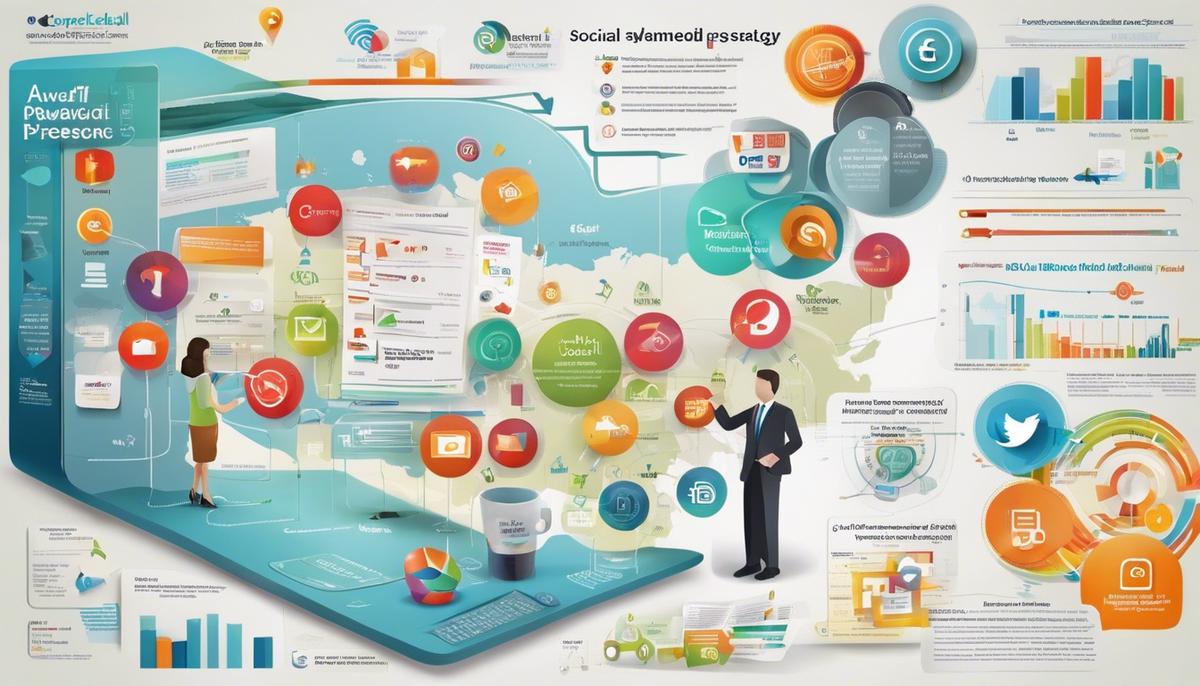Navigating the bustling highways of social media can seem daunting at first glance, with a multitude of platforms each hosting its unique community and language. As we embark on this journey to untangle the web of social media management for beginners, we endeavor to acquire a robust understanding of distinctive networks like Facebook, Twitter, Instagram, and LinkedIn. The exploration ahead will not only shed light on the varied demographics and successful content types per platform but also align them with our overarching business objectives. With every post, tweet, and update, there lies an opportunity to forge a connection with our audience – but it starts with a keen comprehension of the digital terrain we are set to engage.
Understanding Social Media Platforms
Navigating the Social Media Landscape: Platforms Tailored for Varied Audiences
In the dynamic world of social media, understanding the unique features and target audiences of the major platforms is essential. Whether for personal expression, brand promotion, or just staying connected, selecting the right platform can make all the difference.
Facebook: A Community Hub for All Ages
Starting with Facebook, the juggernaut of social connections, the platform is known for its broad demographic appeal, reaching users of nearly all ages. Key features include detailed profiles, the ability to share text, photos, and videos, and robust Group functions. Facebook caters to those looking for community engagement, family and friend updates, and a rich medium for advertisers due to its expansive user base.
Instagram: A Visual Canvas for the Creative
Instagram is the go-to platform for visual storytelling through photos and videos. With a younger demographic skew, particularly among millennials and Gen Z-ers, Instagram is favored for its aesthetic feeds, Stories feature for ephemeral content, and shopping capabilities. Influencers and brands leverage Instagram to showcase visual content, while users enjoy a curated peek into others’ lives.
Twitter: Real-Time Information Exchange
Twitter excels in real-time communication, with a focus on brevity through its character limit. Journalists, politicians, and celebrities frequent this platform to share quick updates, opinions, and engage in public discourse. Twitter’s concise format is ideal for those seeking news, trending topics, and immediate engagement with a global audience.
LinkedIn: The Professional Network
LinkedIn stands out as the principal professional networking site. Its features are tailored for career-oriented individuals and businesses, with options to display resumes, share industry-related content, and post job vacancies. Users include professionals aiming to expand their networks, job seekers, recruiters, and companies establishing their brand in the corporate sphere.
TikTok: Short-Form Video for Entertainment
TikTok has revolutionized short-form video content, capturing a predominantly younger audience. Its addictive scrolling, powered by a sophisticated algorithm, delivers personalized video feeds. Users and brands utilize TikTok to create viral content, leverage soundbites and engage with a community that values creativity and entertainment.
Snapchat: Ephemeral Content for the Privacy-Conscious
Snapchat targets a young demographic with features focused on privacy and transient content. Its self-destructing messages and Stories appeal to those who prefer more secure, casual communication. Augmented reality filters and Snap Map are also unique aspects, attracting users who enjoy playful and innovative ways to share their daily activities.
YouTube: The Video Repository for Broad Interests
Lastly, YouTube serves as a comprehensive repository for video content, covering an extensive range of topics. It appeals to diverse audiences, including educational seekers, entertainment consumers, and DIY enthusiasts. Content creators and viewers flock to YouTube for its monetization potential and vast video library, making it a staple in the world of social media.
Choosing the right platform depends on one’s goals, whether it’s building a following, staying informed, networking professionally or simply sharing life’s moments. With each social media site tailored for specific features and audiences, savvy users can navigate this landscape to find their ideal online community.

Creating Engaging Content
Creating Engaging Content for Platform-Specific Audiences
When aiming to captivate and expand your digital audience, it’s crucial to tailor your content to the unique communities and strengths of each social platform. Let’s delve into the strategies for engaging content creation, focusing on platforms not previously mentioned.
Pinterest: The Visual Discovery Engine
Harness the power of Pinterest’s image-driven platform by curating thematic boards filled with high-quality, aspirational imagery. To create compelling content:
- Identify trending topics in your niche using Pinterest Trends.
- Design visually appealing pins with a balance of eye-catching imagery and succinct text overlays.
- Optimize for search by incorporating keywords into pin titles and descriptions.
- Create step-by-step guides or infographics that offer value and are likely to be saved and shared.
Reddit: The Forum of Niche Interests
Reddit’s diverse communities, or subreddits, are goldmines for those looking to engage with specific interests. To thrive on Reddit:
- Participate genuinely in relevant subreddits; engagement is king.
- Offer unique insights or ask thought-provoking questions to start discussions.
- Use Reddit’s AMA (Ask Me Anything) format to provide expertise and interact with the community.
- Abide by the rules of each subreddit to avoid being flagged for spam.
Medium: The Platform for Thought Leaders
For those seeking to engage an audience looking for in-depth analysis and personal stories, Medium is an ideal venue. To capture the attention of Medium readers:
- Craft compelling stories or thorough articles that offer new perspectives or insights.
- Utilize Medium’s built-in analytic tools to understand what resonates with your readers.
- Engage with other writers through claps and comments to build a supportive community.
- Consider Medium’s Partner Program to monetize content and incentivize quality writing.
Quora: The Q&A Landscape
Quora’s question-and-answer model allows for targeted content that addresses specific user queries. To leverage Quora for audience growth:
- Seek out questions within your realm of expertise, providing thorough and authoritative answers.
- Include personal anecdotes or data to support your answers, increasing credibility.
- Follow topics relevant to your industry to stay abreast of discussions.
- Maintain a complete and professional Quora profile, positioning yourself as a knowledgeable contributor.
Each platform demands a mindful approach that respects the users and the content forms they prefer. By customizing your strategy to channel the inherent strengths and user behaviors of different platforms, you can create content that not only engages but also adds value to the audience’s experience. Navigate these digital spheres with strategic content placement and watch your audience grow, one engaged user at a time.

Analytics and Strategy
Harnessing Analytics to Boost Social Media Strategy
Analytics play a vital role in finetuning your social media approach, turning data into actionable insights and elevating your digital presence. Through analytics, you can measure engagement, track growth, and understand audience behavior, leading to content that resonates and drives results.
First and foremost, establish clear objectives. Define what success looks like – be it brand awareness, lead generation, or customer acquisition. This determines the metrics you should monitor, such as reach, click-through rates, or conversion rates.
Dive into demographic data. Knowing your audience’s age range, geographical location, and preferred content allows for targeted campaigns. Platforms like Facebook Insights give a comprehensive view of who interacts with your content, enabling you to tailor messaging effectively.
Analyze post-performance metrics such as likes, shares, comments, and the average time spent on your content. Platforms like Instagram Insights reveal which posts spur the most engagement. Use this knowledge to replicate successful formats and tweak underperforming content.
Pay attention to follower activity. Identify when your audience is most active using tools like Twitter Analytics. Schedule your posts during these peak hours to enhance visibility and engagement.
Track conversion rates. If your strategy includes driving traffic to a website or landing page, platforms like LinkedIn Analytics can show how visitors from LinkedIn behave compared to other sources. Adjust your call-to-actions and content based on what’s driving the highest conversions.
Examine customer journey analytics. Tools like TikTok’s For Business provide insights into how users interact with ads and content, from views to taking action. This allows brands to understand and optimize the path to purchase or other desired outcomes.
Leverage sentiment analysis. Sentiment analysis gauges the public’s feelings towards your brand. Utilize tools that can scan comments and mentions on platforms such as Snapchat to gauge customer sentiment, enabling proactive reputation management.
Engage with competitors’ analytics. Tools like YouTube’s Analytics allow you to compare your channel’s performance against competitors’. Take inspiration from successful strategies and identify content gaps to exploit.
Monitor social listening. Platforms like Pinterest Analytics offer information on what’s being saved from your website and how users describe your pins. This enables you to jump on trending topics and ensures your content aligns with current conversations.
Refine strategy with A/B testing. Experiment with different content types, captions, or hashtags and measure the results. Apps like Reddit’s analytics enable you to test various elements and see what generates the most interaction, refining your approach with empirical evidence.
Regularly review and adjust. Social media landscapes are continually shifting. Ongoing analysis is essential to remain agile and responsive to new trends and audience preferences.
In sum, leveraging analytics allows you to craft a social media strategy that’s not just informed by data but shaped by it. With meticulous analysis and thoughtful application of insights, your social media footprint can grow deeper and more impactful, capturing attention and converting followers into loyal advocates for your brand.

Embarking upon the world of social media with an informed strategy and a repertoire of engaging content, we can navigate the intricacies of digital interaction with confidence. The alliance between creativity and analytics empowers us to not merely add to the noise but to stand out with intention and purpose. As we continue to harness the power of these insights, tailor our strategies, and adapt to the ever-changing landscape, our journey in social media management will remain both an educative experience and a compelling avenue for growth.




